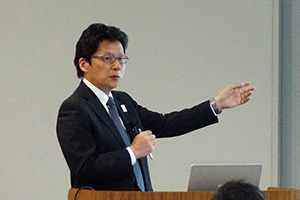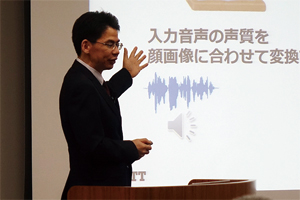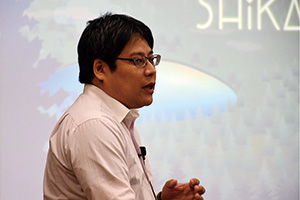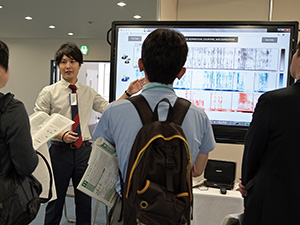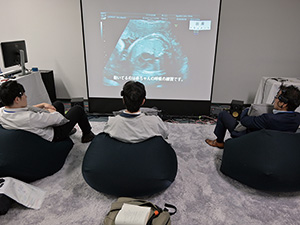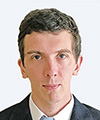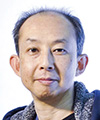 |
|||||
|
|
|||||
|
Information Vol. 17, No. 11, pp. 52–57, Nov. 2019. https://doi.org/10.53829/ntr201911in1 Event Report: NTT Communication Science Laboratories Open House 2019AbstractNTT Communication Science Laboratories Open House 2019 was held at Keihanna Science City, Kyoto, on May 30 and 31, 2019. Around 1500 visitors enjoyed 5 talks and 30 exhibits, which included our latest research efforts in the fields of information and human sciences. Keywords: information science, human science, artificial intelligence 1. OverviewNTT Communication Science Laboratories (CS Labs) aims to establish technologies that enable heart to heart communication between people and people, and between people and computers. We are thus working on a fundamental theory that approaches the essence of human beings and information, as well as on innovative technologies that will transform society. NTT CS Labs Open House has been held annually with the aim of introducing the results of the CS Labs’ basic research and innovative leading-edge research to both NTT Group employees and visitors from business industries, universities, and research institutions who are engaged in research, development, business, and education. Open House 2019 was held at the NTT Keihanna Building in Kyoto on May 30 and 31, and around 1500 visitors attended it over the two days. This year, we invited the former athlete, Deportare Partners Representative, Mr. Dai Tamesue, and held a special talk with NTT Fellow Dr. Makio Kashino. We also tried an outdoor demonstration exhibition for the first time. We prepared many hands-on exhibits to enable visitors to intuitively understand our latest research results and to share a vision of the future where new products based on the research results are widely used. This article summarizes the event’s research talks and exhibits. 2. Keynote speechThe event started with a speech by the Vice President and head of NTT CS Labs, Dr. Takeshi Yamada, entitled “Processing like people, understanding people, helping people—Toward the future where humans and AI will cohabitate and co-create” (Photo 1).
Dr. Yamada pointed out that CS Labs places particular importance on basic research not only toward the development of technology that can approach human abilities but also technology that can be used to elucidate human functions and characteristics and to understand what it means to be human, and technology to help people in their daily lives. In Japan, 2019 has turned out to be both a year marking Reiwa, a new name in the traditional Japanese era system, and a year on the verge of holding the Olympic and Paralympic Games. Dr. Yamada introduced the latest artificial intelligence (AI) technologies developed by CS Labs at this transition point between eras and declared that they will boldly and tenaciously undertake new challenges with a focus on technologies that carry out processing the way people do, and that also understand and help people. 3. Research talksThree research talks were given, as summarized below, which highlighted recent significant research results and high-profile research themes. Each presentation introduced some of the latest research results and provided some background and an overview of the research. All of the talks were very well received. (1) “See, hear, and learn to describe—Crossmodal information processing opens the way to smarter AI,” by Dr. Kunio Kashino, Media Information Laboratory Recent advances in AI and machine learning research are breaking down the barriers between modalities such as language, sounds, and images, which have been studied separately so far. There are various implications for this dramatic change. Most importantly, AI is now achieving a new breakthrough—its ability to learn concepts on its own based on multimodal inputs. The key is to acquire, analyze, and utilize common representations that can be shared among those multiple modalities. In this research talk, Dr. Kashino called this approach crossmodal information processing, introduced its concept, and discussed how it will help people in their future lives (Photo 2).
(2) “Measuring multiple visual abilities in daily circumstances—Towards establishment of daily selfcheck for eye health,” by Dr. Kazushi Maruya, Human Information Science Laboratory The human visual system has considerable interpersonal differences, and its ability varies with the context, task, and circumstances. To grasp the variability in visual ability in daily circumstances, a novel set of eye health-check tests are proposed to measure visual abilities. Each test can be finished in a short time (around 3 min), and some tests are gamified so that users can check their visual ability in an enjoyable way. In this research talk, Dr. Maruya explained the details of this self-check test battery and clarified problems that should be overcome in order to establish daily self-checks of eye health (Photo 3).
(3) “Like likes like strategy: search suitable for various viewpoints—Picture book search system ‘Pitarie’ with graph index based search,” by Mr. Takashi Hattori, Innovative Communication Laboratory A novel method is proposed for finding similar objects in a large-scale database, based on a graph index. Each vertex corresponds to an object, and two similar vertices are likely to be connected. The graph index, constructed using a like likes like strategy, shows small-world behavior: any two vertices can be connected by a small number of steps. A graph index search terminates quickly and is applicable to many types of media, including text, images, and audio. In this research talk, Mr. Hattori introduced Pitarie, an application of this proposed method that enables searching for similar picture books by both text and images (Photo 4).
4. Research exhibitsThe Open House featured 30 exhibits displaying NTT CS Labs’ latest research results. We categorized them into four areas: Science of Machine Learning, Science of Communication and Computation, Science of Media Information, and Science of Human. Each exhibit was housed in a booth and employed techniques such as slides presented on a large-screen monitor or hands-on demonstrations, with researchers explaining the latest results directly to visitors (Photos 5 and 6). The following list, taken from the Open House website [1, 2], summarizes the research exhibits in each category. (Abbreviations in the titles have been defined.)
4.1 Science of Machine Learning
4.2 Science of Communication and Computation
4.3 Science of Media Information
4.4 Science of Human
5. Invited talkThis year, NTT Fellow Dr. Makio Kashino invited the former athlete, Deportare Partners Representative, Mr. Dai Tamesue and held a special talk entitled “Sports in the future and human potentiality.” A wide range of topics was addressed, including mental control, record-breaking discontinuities, collaborative behavior, limit of growth due to premature optimization, language and sports skill communication, and balance of consciousness and unconsciousness. As an athlete who represented Japan in three Olympic Games and as a scientist who is studying brain functions underlying the amazing skills of athletes, respectively, Mr. Tamesue and Dr. Kashino talked about the essence of human nature revealed by the athletic practice and scientific research of sports, and shared their predictions of how science and technology will change sports and humans in the future. The audience engagement was high thanks to the vivid discussion that included a lot of physical gestures. 6. Concluding remarksJust like last year, many visitors came to NTT CS Labs Open House 2019 and engaged in lively discussions on the research talks and exhibits and provided many valuable opinions on the presented results. In closing, we would like to offer our sincere thanks to all of the visitors and participants who attended this event. References
|
|||||









